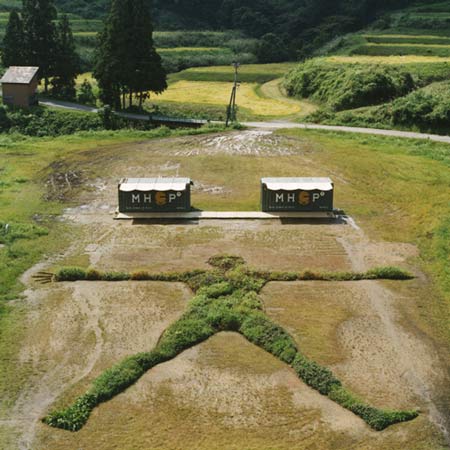
Medical Herbman Café Project by EARTHSCAPE
Japanese landscape design studio EARTHSCAPE have created a giant travelling human-shaped herb garden.
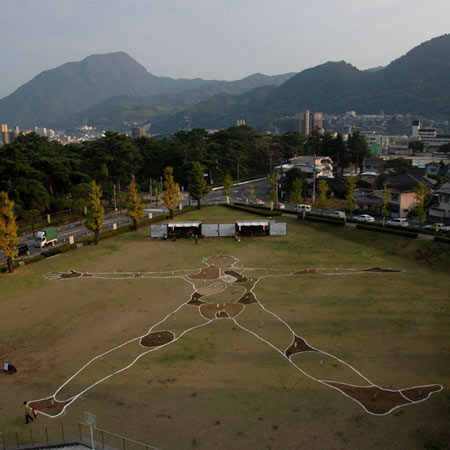
Called Medical Herbman Café Project (MHCP), the garden arrives in shipping containers which convert into a shop and cafe at each location.
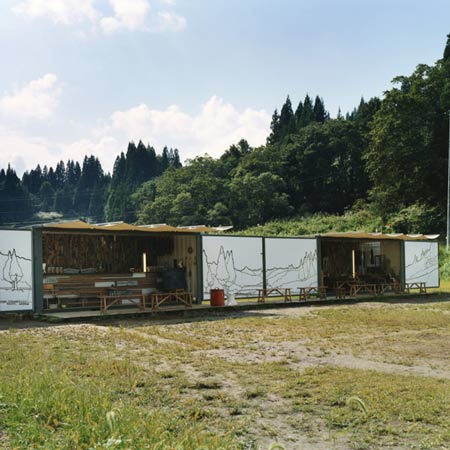
Proceeds from the shop and cafe are used to build playgrounds in developing countries.

Herbs are planted according to the parts of the body they can benefit.
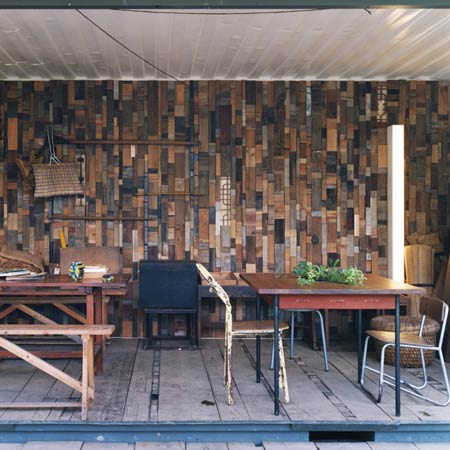
MCHP was set up in three different locations in Japan last year and plans to travel to other countries in future.

Here's some text from Kobayashi:
--
MHCP by EARTHSCAPE
A social action project that is expressed through design work and carried out by the landscape design studio EARTHSCAPE. We consider all the necessary production and activity that occurs around the project, such as the details, related items produced, and the flow of people visiting events -- indeed the entire project -- as a work of design.
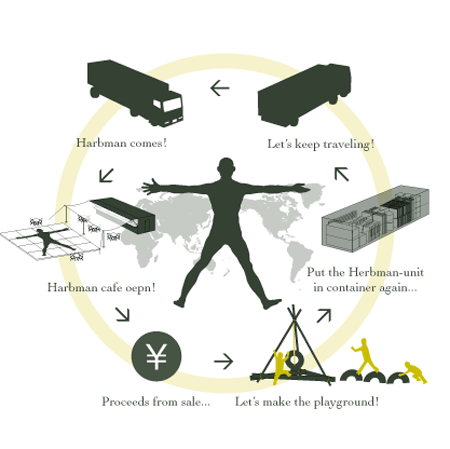
In 2009, MHCP was active in three locations between summer and winter. EARTHSCAPE’s landscape design works have been introduced in media outside of Japan, such as "x1000 Landscape" published by German publisher Braun, but as MHCP did not begin activities in an established format until 2009, this will be our first major overseas exposure.
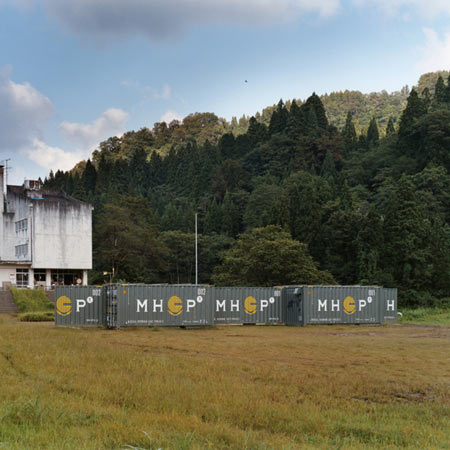
Herbman keeps traveling.
Herbman's entire body is covered with herbs. He travels around the world, using his café to teach people the effects of the various herbs growing on his body. The proceeds from the café are used to construct playgrounds through the Herbman Fund. Herbman keeps traveling, believing in a world where people and nature are healthy, and children are happy and have enough space to play.
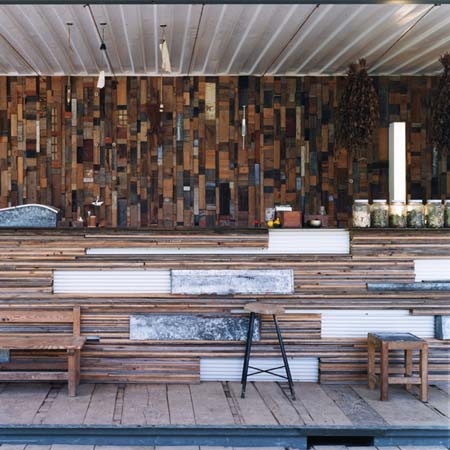
About MHCP
Medical Herbman Café Project (MHCP) is a circular, sustainable program in which we create a human-shaped herb garden named Herbman, and jointly operate a café where we sell tea and food dishes using the herbs harvested from the garden. The proceeds are used toward constructing playgrounds in the schoolyards of elementary schools in developing countries.

It is our goal to spread MHCP across the seas and to a wide range of people, and we have created a kit of all necessary materials and packed it into a sea-ready container that we take with us as we develop our project around the world. Inside the container is a Herbman construction kit, a simple kitchen, and a café unit. We unpack and assemble the Herbman and café on location. The container itself becomes the café space. When the set period for business is over, each item is once again stored in the container, and carried to the next location.
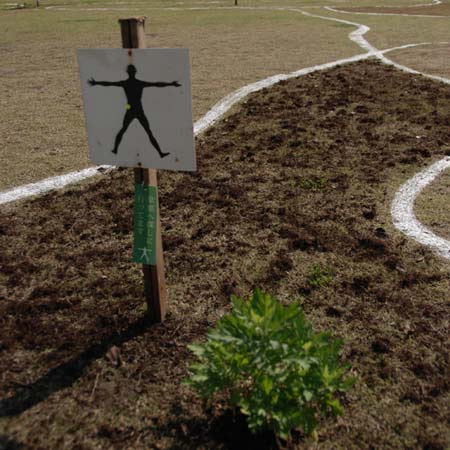
Herbman carries his trunk (the container) as he travels, bringing good health and giving dreams to children wherever he goes. This is the vision of our project.
Herbman
Herbman is a person-shaped herb garden. Various herbs are planted in this garden. Herbs are planted on Herbman’s body according to their effects: for example, herbs that aid digestion are planted in the stomach area, and herbs that work to relieve shoulder stiffness are planted in the shoulder area. In this way, Herbman acts as a kind of herb dictionary. Just by looking at Herbman, people can learn which herbs work for their trouble spots. We also plant herbs that grow naturally in the locale, so that our herbs are constantly changing, and a site-specific Herbman is born in each locale.
Cafe
Through Herbman, people can learn about the effects of herbs. We also build a Herbman Café nearby as a means for people to apply these effects to their own bodies. The container that carried Herbman becomes the café space, and we offer drinks and food made with the herbs harvested from Herbman. We also use this space to hold various workshops relating to herbs.
Container Design
The sea-ready container that forms the basic space, as well as other materials, interior items, and accessories all use recycled parts.
The line drawing on the inside of the container door, which continues to the back of the container, depicts the Echigo-Tsumari region in Japan. We hope that looking at this drawing will encourage people to take the time to notice and deeply observe the landscape of the locale where Herbman and the container are installed. The landscapes of all of Herbman’s destinations are layered on top of the base drawing wherever Herbman goes.
We deconstructed an old abandoned folk house in Echigo-Tsumari, and obtained the antique materials, objects, as well as fusuma (sliding wood doors) and shoji (sliding paper doors) that were used in the residence. We cut the materials into building block-like shapes in four different patterns of length and width. We stacked them vertically, matching their widths, and arranged them in a sort of mosaic. We added some old measure boxes and abacuses that matched in size to the arrangement, which shows the harmonious relationship between the sizes chosen by EARTHSCAPE and Japan’s traditional objects.
For the bar counter, we assembled antique boards into a table shape. We received the edges of aluminum panels, usually destroyed in factories, from the manufacturer, and we worked them into locations on the front surface seen by customers.
The MHCP project advances as it moves through various locales in Japan and throughout the world. The interior of the container acquires new materials and gifts from the locales to which it travels, and evolves with each place it visits, turning into a gallery space where memories of its travels are exhibited.
In Echigo-Tsumari, we were entrusted with items unique to this region, such as baskets, straw sandles, yukiitadome (literally “snow board stops,” wood boards installed to protect windows on the first floor of houses when winter snow piles high in the Niigata Region of Japan), and primitive measuring rods that came from old folk houses. We displayed these items in the space.
Beppu Ver.
When we worked on MHCP in Beppu City of Oita Prefecture, one Japan’s most famous hot spring regions (and a nationally designated City of International Tourism and Hot Springs Culture), Herbman’s body was graphically represented over a total height of 60m. In the vast space, we drew a Herbman map and giant drawings that indicated what works on which part of the different regions of the human figure.
For each section, we planted a bundle of the herbs that work on that part of the body as an example, and installed cards that indicated the herb effects next to the bundle. The cards doubled as ordering cards, so that as people walked over Herbman’s giant body, they could understand which herbs work on which body parts, and could choose the cards that matched the herbs that they wanted to consume. They could then take those cards to the bar counter, and exchange them, along with the price of the tea, for their herbal remedy.
In some locations, instead of ordering cards, we installed message cards with messages from Herbman, such as, “I’m off to search in the fields.”
MHCP by EARTHSCAPE
Designer : EARTHSCAPE www.earthscape.co.jp
Project name : MHCP - Medical Herbman Cafe Project
URL : www.mhcp.jp